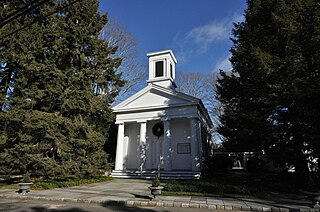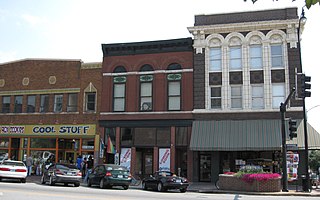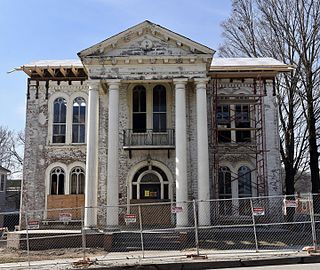
Chatham–Arch is a neighborhood located immediately east of Downtown Indianapolis, Indiana, United States. This neighborhood is one of the oldest in Indianapolis, dating back to the mid 19th century. Chatham–Arch contains many of Indianapolis's historic homes.

The Long Ridge Village Historic District is a historic district in the city of Stamford, Connecticut. The district, located in rural northern Stamford near the border with New York, was listed on the National Register of Historic Places in 1987. Although the district includes a few early 19th-century properties, the area was most heavily developed between 1850 and 1920, and was a local center of shoe manufacturing until it was bypassed by railroads, sending the business nearer to downtown Stamford. The district extends along Old Long Ridge Road, and includes several property on adjacent Rock Rimmon Road. There are 34 historically significant houses, and two churches.

There are 65 properties listed on the National Register of Historic Places in Albany, New York, United States. Six are additionally designated as National Historic Landmarks (NHLs), the most of any city in the state after New York City. Another 14 are historic districts, for which 20 of the listings are also contributing properties. Two properties, both buildings, that had been listed in the past but have since been demolished have been delisted; one building that is also no longer extant remains listed.

The Eighth and Broadway Historic District is one of the seven national historic districts located in Columbia, Missouri. The district is made up of three contributing properties and is located at the intersection of Eighth and Broadway Streets in Downtown Columbia. They consist of the Beaux-Arts style Miller Building (1910), the Italianate style Matthews Hardware, and the Art Deco style Metropolitan Building. Today, the area holds loft apartments and several local business including: Cool Stuff, Hot Box Cookies, Sycamore, Peace Nook, and Geisha.

The Ozark Courthouse Square Historic District is a national historic district located at Ozark, Christian County, Missouri. It encompasses 19 contributing buildings in a 5.3-acre (2.1 ha) area in the central business district of Ozark. The central feature of the district, the Christian County Courthouse, is a three-story, Classical Revival style brick building designed by architect Henry H. Hohenschild. Other notable buildings include the Bank of Ozark/Masonic Lodge (1897), First Baptist Church (1919), Methodist Episcopal Church (1914), Robertson Brothers’ Store (1882), Ozark Drug (1905), Works Progress Administration Community Building (1934), Hospital, and Christian County Bank.

Emory Grove is a small area of bungalow style homes built in 1939 and the 1940s in Druid Hills, Georgia near Emory University. The Emory Grove Historic District, located between Emory University and the city of Decatur, Georgia, is a 90-acre (36 ha) historic district that was listed on the National Register of Historic Places in 2000.

Hedgesville Historic District is a national historic district located at Hedgesville, Berkeley County, West Virginia. It encompasses 55 contributing buildings and one contributing site, the Town Spring. Notable buildings include the Presbyterian Church and Manse, Ashton House, Robinson Log House, Hat Shop, Stuckey House, Westenhaver-McKee House, Mt. Zion Episcopal Church and Hedgesville Cemetery, Jacob Hull Mansion, and Bodine's Tavern. Included are notable examples of Queen Anne and Greek Revival-style architecture.

Moundsville Commercial Historic District is a national historic district located at Moundsville, Marshall County, West Virginia. It encompasses 72 contributing buildings in the central business district of Moundsville. They are large 2-4 story brick buildings reflecting the Georgian and Late Victorian styles. Notable buildings include the Marshall House, Roberts House, F.O.E. Building (1940), State Food Store (1939), Simpson United Methodist Church (1907), First Christian Church (1899), St. Francis Xavier Roman Catholic Church (1917), Strand Theater (1920), Marshall County Courthouse (1876), and Post Office and Federal Building (1914). Located within the district is the separately listed Ferrell-Holt House.

Woodsdale–Edgewood Neighborhood Historic District is a national historic district located at Wheeling, Ohio County, West Virginia. The district encompasses 969 contributing buildings and is primarily residential, developed between 1888 and 1945. A number of popular architectural styles are represented including Shingle Style, Queen Anne, Tudor Revival, American Foursquare, Colonial Revival and Bungalow style. The district also includes four Lustron houses. Notable non-residential buildings include the Edgwood Christian Mission Alliance Church (1932), St. John's (1913), Mount Carmel Monastery (1915) designed by Frederick F. Faris (1870-1927), and Good Shepherd Home (1912). Also located in the district are the separately listed H. C. Ogden House and William Miles Tiernan House.

The Old Mt. Carmel Cemetery, Wrought-Iron Cross Site, near Balta, North Dakota, is a historic site of wrought-iron crosses that was listed on the National Register of Historic Places in 1989. The listing included six contributing objects.

Ashville Historic District is a national historic district located near Marshall, Fauquier County, Virginia. It encompasses 16 contributing buildings and 1 contributing site in the Reconstruction-era African-American rural village of Ashville. The district contains nine properties, including the Gothic Revival style Ashville Baptist Church (1899), Ashville School (1910s), Ashville Community Cemetery, and a concentration of historic dwellings and related outbuildings.

Fayette Street Historic District is a national historic district located at Martinsville, Virginia. It encompasses 116 contributing buildings, in a traditionally African-American section of Martinsville. It includes a variety of commercial, religious, educational and residential buildings dating from the late-19th century through the mid- 20th century. Notable buildings include the Dennis Hairston House, community Market (1925), Mt. Carmel Church, Grace United Presbyterian Church, Albert Harris Intermediate School, Alex Hairston House, Baldwin Block, Watkins-Hairston Funeral Home (1931), Gordon Building (1941), and the Imperial Savings and Loan (1953).

Mount Carmel Historic District is a national historic district located at Mount Carmel, McCormick County, South Carolina. The district encompasses 40 contributing buildings in Mount Carmel. They were built between 1885 and 1920, and include residential, commercial, institutional, religious, and industrial buildings. Notable buildings include Baker's Store, John Cade House, John W. Morrah House (1896), and the Mount Carmel Presbyterian Church.

Mount Vernon Springs Historic District is a national historic district located near Bonlee, Chatham County, North Carolina. The district encompasses 23 contributing buildings, 3 contributing sites, and 7 contributing structures in the rural village of Mount Vernon Springs. The village grew up near a locally famous mineral spring. Notable buildings include the Greek Revival style Female Dormitory of the Baptist Academy (1855), Gothic Revival style Mt. Vernon Springs Presbyterian Church (1885), the John C. Kirkman House, Robert P. Johnson House, and John M. Foust House. Also located in the district are the Mt. Vernon Springs, the Baptist Academy Cemetery, and the Mt. Vernon Springs Presbyterian Church cemetery.

The West Liberty Commercial Historic District in West Liberty, Iowa, United States, is a historic district that was listed on the National Register of Historic Places in 2002. At that time, it included 41 contributing buildings, six other contributing structures, and eight non-contributing buildings.

Historic District E is a national historic district located at Boonville, Cooper County, Missouri. It encompasses 88 contributing buildings in a predominantly residential section of Boonville. The district includes representative examples of Late Victorian style architecture. Notable buildings include the Dyer Residence (1870), Burns Residence, Rennison Residence (1890s), Lauer Residence (1830-1833), Robinson Residence (1905), Bell Residence (1886), Schuster Residence (1833), Kempf Residence (1890s), Cooper County Court Property, Morgan Street Baptist Church (1884), Waible Residence (1833-1848), and United Church of Christ.

Luce-Dyer House, also known as the Stark-Carlson House, is a historic home located at Louisiana, Pike County, Missouri. It was built between about 1856 and 1860, and is a two-story, three bay, Italianate style brick dwelling. It features a bracketed cornice, gabled roofline, five pairs of semi-circular topped windows with oscula, and pedimented Neoclassical front portico added in the 1930s. Also on the property are the contributing garage and cottage.

North Third Street Historic District is a national historic district located at Louisiana, Pike County, Missouri. The district encompasses 61 contributing buildings, 1 contributing site, and contributing structure in a predominantly residential section of Louisiana. It developed between about 1843 and 1935, and includes representative examples of Greek Revival, Gothic Revival, Italianate, Queen Anne, Colonial Revival, and Bungalow / American Craftsman style architecture. Located in the district are the separately listed Louisiana Public Library and Luce-Dyer House. Other notable buildings include the William C. Hardin House, James H. Johnson House, Edward G. McQuie House, St. Joseph's Catholic Church (1874), and Frank Boehm, Jr. House.

Samuel T. and Mary B. Parnell House, also known as Mt. Branson Lodge, is a historic home located near Branson, Taney County, Missouri. It was built about 1912, and is a two-story, American Craftsman style dwelling constructed of irregular rubble courses of native stone. The front facade features a partial-width, two-story porch supported by massive, battered stone piers. Also located on the property is a contributing one-story, rock and wood frame garage.

The Pittsburg Commercial Historic District, in Pittsburg, Texas, is a 32 acres (13 ha) historic district which was listed on the National Register of Historic Places in 2013. It included 66 contributing buildings and one contributing site, as well as 21 non-contributing buildings. Four buildings within the district are Recorded Texas Historic Landmarks (RTHL).


























